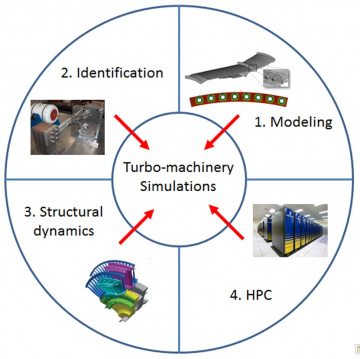Description
Energy and Mobility are two primary driving forces in the 21st century. Development of incremental and disruptive technologies will have key impacts on the world’s societies, and on safety, security and competitiveness of Europe. Amongst those technologies, turbines will play a major role. Recovery of shale gas depends decisively on compressors. Modern gas supplied power plants are bridging towards the age of renewable energies. Aero-engines are to undergo the most massive changes in their history with the advent of composite materials, gear boxes, and turbine-electric concepts separating generation of power and thrust.
The correct analysis of the dynamic response of a turbine is of uttermost importance since it impacts the performance of the system, defines its reliability and maintainability, and is a major driver for high cycle fatigue and potential catastrophic failure. Due to the design of the turbines with its many joints and the complexity of the experienced excitation, a strongly nonlinear dynamic response can be observed during engine operation, leading to a very challenging requirement for the analysis.
A large research effort over the last few decades has significantly moved industries capabilities forward enabling todays the detailed analysis of small component assemblies, such as bladed disk sectors including different friction joints (root, underplatform dampers, shrouds, …) under consideration of geometric nonlinearity. As useful as these specialised models are when it comes to understanding a very localised effect of nonlinear dynamics, todays state of the art is nowhere close enough to providing the capabilities to accurately model the nonlinear dynamic behaviour of large scale turbomachinery models.
EXPERTISE addresses some of the challenges on the way to a fully validated nonlinear dynamic model of turbo-machinery components, by bringing together world leading institutions and companies from across Europe in a multidisciplinary project.
 The ultimate research objective of the EXPERTISE project is to develop advanced tools for the dynamics analysis of large-scale models of turbine components to pave the way towards the virtual testing of the entire machine (i.e. whole engine simulations). Thus, the research programme of EXPERTISE is based on the following Work Packages (WPs):
The ultimate research objective of the EXPERTISE project is to develop advanced tools for the dynamics analysis of large-scale models of turbine components to pave the way towards the virtual testing of the entire machine (i.e. whole engine simulations). Thus, the research programme of EXPERTISE is based on the following Work Packages (WPs):
WP1 – Advanced modeling of friction contacts
WP2 – Identification of contact interfaces
WP3 – Structural dynamics of turbine and its components
WP4 – High Performance Computing for structural dynamics
In WP1, research will aim at improving the understanding of the physics of friction contacts in order to develop and validate advanced models for dynamic simulations of turbomachinery models. There is a strong need for advanced contact models, since state-of-the-art contact models are unsatisfactory: when experimental validation is performed, an intense tuning of the models is necessary for numerical predictions to accurately match the experimental results. It is the symptom of a lack of knowledge in the contact behavior.
In WP2 an alternate approach will be investigated to characterize the contact interfaces: inverse methods based on experimental identification. In this WP, ad hoc measurements are performed first on the disassembled components and then on the assembled structure with the aim of identifying the unknown parameters of the contact from the measured dynamic behavior.
In WP3 the models developed in WP1 and identified in WP2 will be implemented in efficient analysis tools for the nonlinear dynamics of turbomachinery components. These analysis tools must be developed ad hoc, since commercial software packages are not able to run time domain analyses of highly refined finite element models, typical of industrial applications, in a reasonable amount of time (i.e. less than one hour) that would allow engineers to use detailed models when optimizing designs and performing uncertainty analysis. Within the EXPERTISE project, highly efficient analysis tools will be developed and validated by following two different and complimentary approaches. The first approach relies on the development of Reduced Order Models (ROMs) able to reduce the size of the nonlinear model and thus the calculation time, preserving the required accuracy. The second approach relies on Domain Decomposition Methods (DDMs) in order to split the model into submodels solved by means of parallel computing algorithms.
Nonlinear dynamic analyses are very time consuming even when ROMs and DDMs are implemented, thus the computational efficiency of the numerical solvers is mandatory to allow accurate nonlinear modeling techniques to be implemented in the early design phases and highly accurate component and full system finite element models to be analyzed. In WP4 research in the HPC field is planned with the objective of increasing the productivity of applications developers, in particular in the area of nonlinear structural dynamics. Currently, the two most challenging problems for non-expert HPC users are extracting sufficient parallelism from the application, and doing I/O in an efficient manner. In order to address these problems, research in HPC will be focused on data-dependency, task-parallelism, and high-level abstractions of I/O operations.
